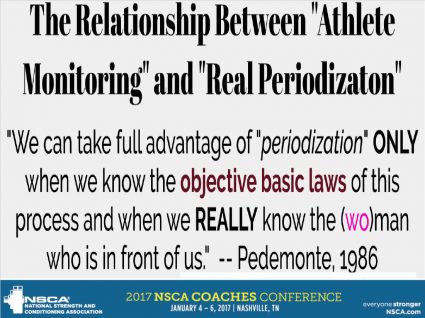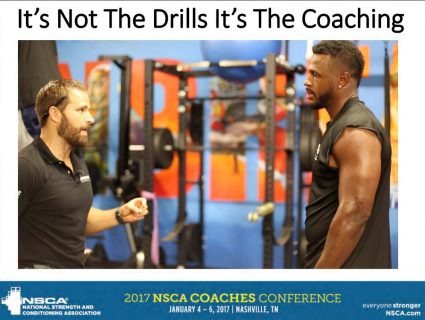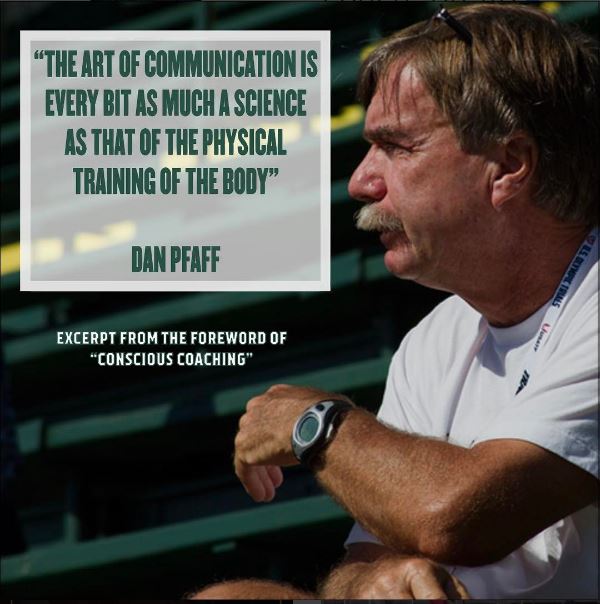Enter The Age of Technology:
With explosion of athlete assessment tools in the last decade, everything from movement assessments (FMS), train-ability assessments (HRV), genetic assessments to immediate power output assessments (catapult) training variables and physiology can easily be measured.
On the cheap and in, or almost in, real-time.
When I first read about the Omegawave (HRV monitor), from Charlie Francis forums, the cheapest model was 10K. Now you can get a fairly reliable HRV app on that magic box that lives in your pocket for under $100, and that’s the better ones out there. You can get a crappy one for FREE…
These are all INCREDIBLY powerful tools,
And I agree,
“If you’re not testing, you’re guessing.”
With all this data available in real-time, it’s now very easy to get quantifiable feedback from the athletes performance and physiological state almost simultaneously as the workout is progressing.
You don’t have to guess about if the athlete is recovered enough, how much volume load they can handle, if today’s workout is stressful for them or how well they are moving.
It’s easy to look at the data and change course.
So I have to ask,
Does Coaching Still Matter?
Does the guy looking at the data actually matter anymore?
Theoretically, you could just make up a matrix and spreadsheet.
As the athletes numbers changed during the workout and moved along you could adjust the workout accordingly in correspondence to what the spreadsheet says.
Has the availability of data taken the coach out of the equation?
Are we now in the age of Machines?

Hell No!
For me, the greatest athlete assessment software resides in the eyes, ears and brain of a capable coach.
Data only tells us where we’ve been and where we are not necessarily where we’re going and how to get there.
That’s where the coach comes in.
Somebody’s gotta drive the car.
Every day is different, no two will ever look the same.
What physical capabilities you have available to you changes day-to-day based on the allostatic (stress) load you’re under.
Things like your range of motion, strength, speed, how much volume you can handle, how quickly you recover, are all constantly changing, depending on who you are, where you’ve been and where you are. <—your allostatic load vs your recovery capabilities
Therefore, the best program is not the one on paper, on the spreadsheet, but the one that adapts with the athlete, day-to-day.
It’s not that periodization or planning and monitoring doesn’t work and doesn’t matter anymore.
But instead,
the most fundamental concept of periodization has been misunderstood:

From Keith Scruggs presentation at the NSCA Coaches Conference 2017
The Individual….
and how whats done in training today to that INDIVIDUAL and the STATE they are presently in, will enhance or retard progress for that athlete tomorrow.
To effectively periodize the COACH must know the INDIVIDUAL in front of them.
An app cant do that.
How that athlete normally acts in regards to training.
How they look, walk, how they hold themselves, how they talk.
Only then can we really, truly, have an individualized/ periodized program.
If an athlete is normally all jacked up on Mountain Dew and excited to be there but they come in quiet and looking like death warmed over one day…
Probably not the day to go chasing personal bests. But its’ often much deeper and more subtle than that.
“As you watch your athletes move, you watch them dynamically warm up, they’ll tell you. Their bodies will talk to you.
One of the best ways to assess your athletes is when you get ’em all together. If they’re a bunch of chatty cats, like a bunch of old women that can’t shut up, they’re ready to go. But if they’re all just laying on the foam roller, with a dead-eyed look, no music or sound, you’d better be able to change and adapt your program.” –Buddy Morris
Programming needs to be fluid.
Brett Bartholomew: “Dan Pfaff walked up to me and asked, “How do you assess your athletes readiness?”. I told him, “I observe and ask questions”. He (Dan Pfaff) puts his eyes down and walks away.
BB: I’m left wondering what the hell I said, did I look like a moron, did I piss him off? Later on I walk up to him and ask, “Coach, you never replied to my answer about how I assess my athletes day-to-day. I was just wondering what your thoughts were?”.
Dan Pfaff:
“I was just making sure you know what the hell you are doing”.
Keys to Successful Coaching (I’m assuming you understand programming basics, if not, start there):
#1 Watching
Things like: proficiency of movement. smoothness, body language and facial expressions ie no pain face
Simply watching your athlete can tell you a lot.
Do they look like a million bucks walking in? Or a piece of sh@t?
Shoulders rounded over or upright?
Smooth, confident gait, or a slight hitch?
Constantly rubbing the elbow?
Always reaching back and touching the lower back?
Are things different FOR THAT PERSON today?
All of those things are clues.
#2: Asking questions/ Listening
What’s up?
What’s new?
How is X,Y,Z?
What’s going on today?
Once you’ve established that relationship, once they trust that you actually give a damn they’ll give you insight into what’s going on but you need to
LISTEN
to what the athlete says.
If they’re worried about grades, relationships (wifes, girlfriends), finances, business decisions (hiring, firing, deals), their kids, etc, etc.
They’re under TREMENDOUS STRESS and accumulating more through training. <—click the link, watch and listen to the video.
That MUST be accounted for, by the coach (even if you are your own), in the training program. Just asking some questions about what’s going on in their life can tell you a LOT about what you have available to work with that day.
#3: Being Open To Change at ANY Minutes Notice
There are no special exercises.
There are no sacred cows.
I get asked all the time,
“If there was one exercise that you just HAD to do for sport X what would it be?”
Honestly, i have no answer.
Every athlete is different and what they need and get the most out of will change based on THAT ATHLETE more so than the sport in my opinion.
Someone says, “that doesn’t feel right”.
Change.
Maybe it’s an anomaly and next time that exercise is fine.
Today, that’s not the case.
Do no harm.
Client: “last time we did X, Y, Z and later this happened”
Change.
Yeah, the exercise itself probably didn’t create actual damage.
But in the snow ball culture of injuries <—-this means, “I’ve got a snowball and I’ve got to throw it at someone or something, rather than look at my daily activities, postures, sleep and nutrition.”
As a coach, you’re usually better off swapping out that exercise rather than forcing someone into an exercise that they have ZERO confidence performing.
Don’t create a negative environment.
Their anxiety is already high enough.
Trying to perform an exercise that heightens this anxiety will only negatively impact performance.
#4: Effectively COMMUNICATE What You Need The Athlete to Do
Mind readers your clients and/ or athletes are not.
In fact, even if you see them 2-4 times a week, they generally have NO CLUE what the hell is going on.
FACT: They just don’t care about it as much as you.
They’re not supposed to.
Clients: They pay you to think FOR THEM and keep them safe through it.
Usually they are NOT natural athletes.
That can’t be a crutch a coach leans on.
Good movement is a struggle for many of these folks.
Tough shit….coach em up, get em better
While we strive for perfection , we can live with acceptable (better than when you came in) if need be.
Athletes: They’re here to get better at their sport. You’re lucky if 1 in 10 actually pays attention to what the hell you’re saying.
Point being: YOU (as the coach) need to find a way to EFFECTIVELY communicate what you need them to accomplish, don’t EVER expect them to know, EVEN IF YOU’VE DONE THE SAME DAMN THING 100x’s BEFORE.
4 Ways to Get what you Need Out of Clients and Athletes:
#1: Show them.
NEVER guess they know, show them. Make the demo perfect and EXPLAIN as you perform.
#2: Coach them…
Get in the game, earn your paycheck.
Constructive feedback on EVERY rep.
“Coach every rep of every lift”- Buddy Morris.
Be a coach, not a cheerleader.
#3: Cueing
Externally focused cues almost always.
The amount of information should be kept at a minimum within an external focus and prioritized towards critical elements of the movement skill being taught. –Nick Winkleman
Example:
When coaching a glute bridge, instead of:
“Squeeze your glutes” <–internal focus
Try :
“Press the belt buckle to the ceiling” <—-external focus
For the floor press, try:
“Push yourself through the floor, away from the bar” <—-external focus
Instead of:
“Keep your upper back tight the whole time” <—-internal focus
External focus cueing, it’s just plain more effective.
#4: Be Hands On
Touch people.
Touching where you want something to happen is INCREDIBLY effective at creating instant change.
In a perfect world as the client or athlete progresses you can use less touch leading to eventually none.
But, sometimes you need to be all up in their junk to get them right.
I tell folks all the time,
“I pretty much just spend all day poking people in their butts”.
I know, we’re real PC today and this might get me in trouble some day, but so far I’ve gotten away with it.
Believe me, it ain’t glamorous.
But(t) it works….
I stole this image off Brett Bartholomew. He has a book coming out soon, it’s probably gonna be boss.
Has Technology Killed The Coach?
Not yet.
Technology is great, it’s opened up understanding and given us data that we, as coaches, could have only guessed at before.
But those are only numbers, data on a spreadsheet.
A road-map of where you are right now.
Reassurance and a double-check to let you know what you see with your eyes and think in your head is actually happening.
You still need a capable captain to take that data in, understand what it means not just in raw numbers and scores, but when applied to that INDIVIDUAL, and steer the ship where it needs to go.
A reporter asked Charlie Francis how he managed the training of his sprinters.
What was his “plan of periodization”?
His response:
If it looks right, it flies right. I watch, and when things begin to look less than perfect we stop.
While he always had a plan, that plan was mostly an outline or objectives for the day and not set numbers of reps, weights etc.
It was all fluid and changed during the workout day-to-day as things progressed
An app on your phone can’t do that.

From Brett Bartholomew and his most excellent presentation at the NSCA Coaches Conference.




[…] There is NO physiological monitoring device that is superior to whats inside you already. (A good coach can help too). […]